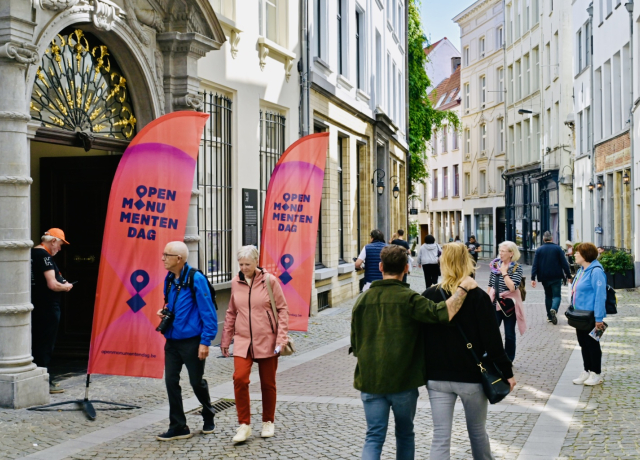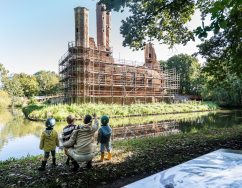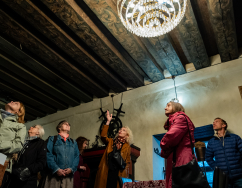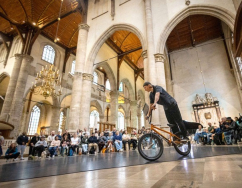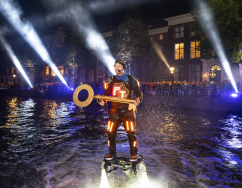European Heritage Days Article:
Open Monumentendag in Antwerp: Exploring Antwerp’s Architectural Heritage
European Heritage Days Article:
Open Monumentendag in Antwerp: Exploring Antwerp’s Architectural Heritage
Photo: De Hofkamer, Credits: Frederik Beyens
On 14 September, Flanders opened its doors to hidden treasures and architectural stories as part of Open Monumentendag (OMD) — Flanders’ annual celebration of built heritage and the region’s contribution to the European Heritage Days programme.
First organised in 1991, Open Monumentendag has grown into one of Flanders’ most beloved cultural events, inviting residents and visitors alike to explore historic sites that are usually closed to the public. Each September, hundreds of monuments, churches, archives, gardens, and private homes reveal their secrets, encouraging people to reconnect with the past and reflect on how heritage shapes the places they live in today.
The event is coordinated by Herita, the Flemish heritage organisation responsible for safeguarding and opening up historical sites across the region. Herita works closely with local organisers, municipalities, volunteers, and heritage institutions, who together make the weekend possible. The initiative also enjoys the support of partners such as the Nationale Loterij, whose contributions help fund outreach and community engagement.
In Antwerp, this year’s edition featured a captivating visits that reflected the city’s architectural diversity and ongoing spirit of renewal. I had the pleasure of being accompanied by Griet Langbeen, the National Coordinator for Flanders, whose knowledge and enthusiasm for cultural heritage made this open-door journey through Antwerp even more engaging. From transformed churches and university campuses to archives and ceremonial halls, each venue told a story — not only about the city’s past, but about how heritage continues to live and evolve.
Onze-Lieve-Vrouw van Gratiekerk / Theater Elckerlyc
The journey began at the Onze-Lieve-Vrouw van Gratiekerk, a neo-Gothic church built in the late 19th century by architects Bilmeyer & Van Riel. Once a house of worship, it was deconsecrated in 2007 and recently found new life as the foyer for Theater Elckerlyc. The building, protected since 1999, is being carefully renovated to preserve its stained glass and structural grandeur. The transformation from church to cultural venue captures Antwerp’s evolving identity — where historic spaces continue to serve community life in new forms.
Campus Opera
At Jezusstraat 28, the former Provincial Safety Institute — once a training centre for harbour workers — has been reborn as KU Leuven’s Campus Opera. The mid-century modernist building, designed in the 1950s, underwent a sensitive restoration by B-architecten, reopening in 2024.
During the renovation, an inserted floor that had blocked the original atrium was removed, and a grand staircase demolished in the 1990s was painstakingly rebuilt. The result restores the vertical openness that defined its post-war optimism. It was even shortlisted for Antwerp’s Erfgoedjuweel (Heritage Jewel) award, a recognition that shows how modern heritage can be just as significant as older monuments.
Heritage House Van Celst
Hidden in Sint-Jacobsmarkt 15, the Heritage House Van Celst offers a more intimate encounter with Antwerp’s layered architectural past. The house brings together decorative and structural elements from several style periods, reflecting the city’s continuous evolution.
Now owned by a non-profit organisation, the house illustrates how civic engagement can preserve domestic heritage — the kind that often disappears quietly behind larger public monuments. Its blend of private initiative and historical integrity ensures that Antwerp’s quieter architectural voices are not forgotten.
Sint-Jacobs Church
Nearby, Sint-Jacobs Church rises in stately grandeur, its towers wrapped in scaffolding as restoration work continues. The church is not only a monument of Gothic and Baroque architecture, but also a place of deep artistic resonance: it houses the tomb of Peter Paul Rubens, Antwerp’s most famous painter.
Over centuries, Sint-Jacobs has adapted to changing times, surviving wars, reforms, and restorations. Its current conservation project aims to preserve both the structure and its intricate artworks, ensuring that this space — a dialogue between faith and art — continues to inspire future generations.
De Brabantse Olijfberg
In the afternoon, De Brabantse Olijfberg offered one of the most layered and fascinating stories of the day. Founded in the 17th century as a clandestine Protestant congregation — its name, “The Olive Mountain of Brabant,” a poetic disguise during the Counter-Reformation — it survived centuries of religious upheaval.
The building itself once served as a Catholic convent, later a military bakery and even a stable, before being reclaimed as a Protestant church. During Open Monumentendag, the community invited visitors to join in organ sing-alongs and historical re-enactments of 19th-century preaching, bringing this long history to life.
Local legend even tells of a ghostly encounter in 1826, when passersby reported mysterious lights flickering in the locked church. The cause turned out to be moonlight reflecting off polished church silver — a tale that has since entered Antwerp folklore.
Today, De Brabantse Olijfberg continues its legacy of openness, hosting refugee projects, student gatherings, and multilingual services, embodying the living spirit of tolerance and inclusion.
FelixArchief
At Oudeleeuwenrui 29, the FelixArchief opened its doors to exhibitions marking 100 years of Art Deco and seven centuries of urban archaeology. But behind the displays lie remarkable archival discoveries.
Earlier this year, archivists identified Antwerp’s oldest known document — a 9th-century parchment fragment of St Augustine’s Enarrationes in Psalmos, found reused as bookbinding material. Such finds reveal how much of history survives by accident — rediscovered only through patient research.
FelixArchief also preserves thousands of 19th-century photographs by Edmond Fierlants, who documented the city’s transformation as its old walls came down. Through these images and documents, the archive reminds visitors that heritage is not only built of stone and glass, but also of paper, memory, and imagination.
De Hofkamer
The day concluded at De Hofkamer, an elegant 18th-century garden pavilion tucked behind the Den Wolsack mansion. Built in 1772 by merchant François Van den Bogaert, it once hosted private receptions and soirées that showcased the family’s wealth and artistic taste.
Inside, the ceiling astonishes: a 65-square-metre painting of “The Gods on Mount Olympus”, believed to be the largest ceiling painting on canvas in Western Europe. Even more surprising is a “bookcase toilet”, where the lavatory is disguised as a library — an eccentric detail that reveals the era’s playful luxury.
After years of neglect, De Hofkamer was fully restored between 2013 and 2017, its clock and ceiling painting meticulously conserved. Today it serves as both a heritage site and cultural hub, offering concerts, talks, and open days. Hidden from the street, it remains one of Antwerp’s best-kept secrets — a tranquil oasis where art, architecture, and storytelling meet.
This year’s Open Monumentendag in Antwerp demonstrated how heritage is not frozen in time but constantly reinterpreted through new uses, restorations, and community initiatives. Whether in a repurposed church, a revived archive, or a centuries-old home, each space offered a dialogue between past and present — reminding visitors that heritage thrives when it remains open, shared, and alive.
